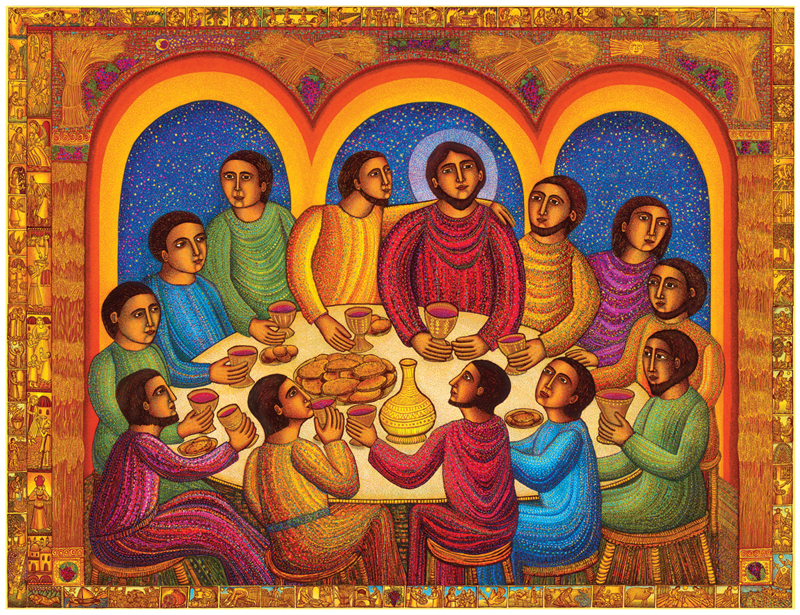One Last Meal -- A Reflection for Holy Thursday
It is
time for the church to gather and remember that last meal Jesus shared with his
disciples. As with every service or event of Holy Week in the year 2020,
whatever we do will be done virtually. It might be a service broadcast live from
Facebook or a gathering on Zoom (or some other similar format). It won’t be a “normal”
Maundy Thursday gathering, and yet we can still take hold of the message of the
moment.
On this
particular day, the Last Supper is the defining event. Two different traditions
frame this meal. The Synoptic Gospels (Matthew, Mark, and Luke) envision Jesus
gathering together with his disciples to celebrate a Passover meal. This is why
Jesus had come to Jerusalem with his disciples. Passover was a pilgrimage feast
that marks the movement of the Jewish people out of slavery in Egypt that was to
serve as a “day of remembrance for you. You shall celebrate it as a festival to
the Lord; throughout your generations you shall observe it as a perpetual
ordinance” (Exodus 12:14). In many ways, the version of this meal shared with
us by Matthew, Mark, and Luke, incorporates this call to remember and to do so
perpetually throughout all generations.
It worth
noting that as western Christians (Roman Catholics and Protestants) gather for
this service of remembrance in 2020, it is the second night of Passover in the
Jewish tradition. While the first night is usually a family event, sometimes
the second night of Passover is celebrated at the synagogue. So, as we gather in
our differing ways it worth remembering that Holy Week is defined by the
Passover, which began yesterday and will continue for eight days in total.
While
the Synoptic Gospels focus on Jesus’ words of institution, which Paul also
records though without reference to Passover, John has a meal, but it’s not
Passover and there are no words of institution. John’s meal is the meal of preparation
for Passover. The actual Passover meal was to be shared the following evening,
but Jesus never made it to that last Passover meal. He would die on the cross
in the hours before Passover began. So instead of a Passover meal with the words
of institution, John pictures Jesus washing the feet of the disciples. In our
day no one has better exemplified the symbolism of Jesus washing of the feet of
the disciples as a sign of humility and service than Pope Francis. Francis is
well known for washing the feet of prisoners on Holy Thursday instead of
washing the feet of the bishops serving at the Vatican.
As with
the creche at Christmas, we tend to merge the two traditions. Thus, many
churches will share the Lord’s Supper and provide a service of foot washing. Perhaps
that’s appropriate. Besides, whether the meal was held on Passover or the night
before Passover still defines the week.
Regarding
the words of institution, which are pronounced over most communion elements,
there are four versions present in the New Testament. There are three versions
found in the Synoptics, which are very similar. Then there is the version found
in Paul’s first letter to the Corinthian church. This is the earliest New
Testament attestation of the meal and the call to remember. Paul doesn’t directly
connect this to Passover but instead sets in the context of betrayal. It was
the night of his betrayal that he shared the meal and gave it a permanent
definition. Here is Paul’s version of the story:
23 For I received from the Lord what I also handed on to you, that the Lord Jesus on the night when he was betrayed took a loaf of bread, 24 and when he had given thanks, he broke it and said, “This is my body that is for you. Do this in remembrance of me.” 25 In the same way, he took the cup also, after supper, saying, “This cup is the new covenant in my blood. Do this, as often as you drink it, in remembrance of me.” 26 For as often as you eat this bread and drink the cup, you proclaim the Lord’s death until he comes. (1 Corinthians 11:23-26).
These
are familiar words. In traditions like mine that provide weekly communion, they
are likely as well known to the people as the Lord’s Prayer (which we include
in our communion prayer). While Christians may differ as to the intent of these
words, whether we’re simply invited to remember or whether the elements of bread
and wine/juice are transformed into the body and blood of Jesus, they do serve
as a call to participate in the life of Jesus.
May we, if we are Christians, embrace this call to participate in the
life of Jesus, especially at a time like this, when so many around the world
are suffering from a Pandemic that makes people sick, causes them to die, leads
to losses of jobs, and social isolation. May we remember Jesus, who offered
himself for others.
In the
words of a nineteenth-century hymn, may we sing:
Be known to us in breaking bread,
but do not then depart;
Savior, abide with us, and
spread thy table in our heart.
There sup with us in love
divine; they body and thy blood,
That living bread, that heavenly
wine, be our immortal food.
—James
Montgomery, 1825
Image Attribution: Swanson, John August. Last Supper, from Art in the Christian Tradition, a project of the Vanderbilt Divinity Library, Nashville, TN. http://diglib.library.vanderbilt.edu/act-imagelink.pl?RC=56552 [retrieved April 8, 2020]. Original source: www.JohnAugustSwanson.com - copyright 2009 by John August Swanson.


Comments